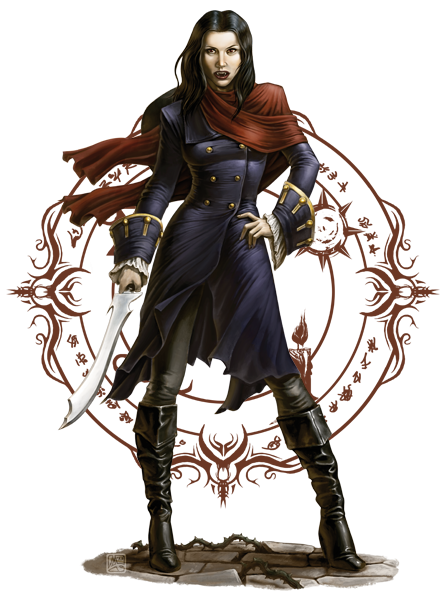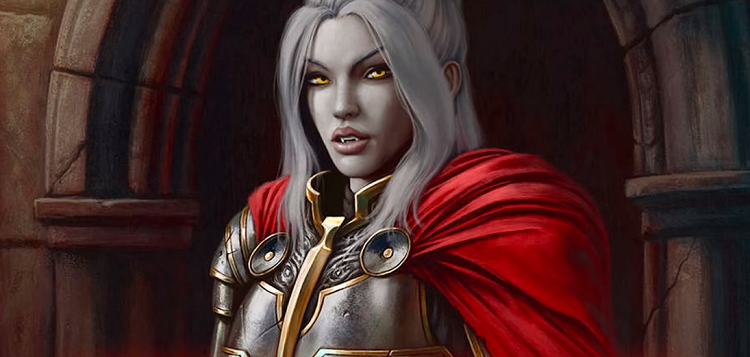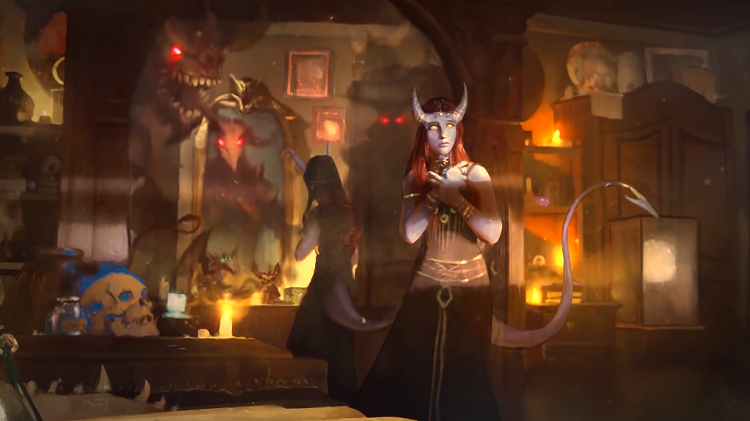The National Gazzette Philadelphia’s 1820 “Vampire Craze” is one of the earliest accounts of romanticizing the otherwise feared undead of the Slavic or Balkan mythology.
Since then, the world has seen an unending wave of affection for the genre, especially when paired with its Lycanthorpy counterpart. From Count Dracula in the Dracula movie to the Twilight Saga’s Edward Cullen, there are many portrayals of the gothic vampire aesthetic even today.
It should be no surprise then that Vampires found their spotlight within the world of D&D, which they have been a part of since the first edition, but it wasn’t until the release of the Curse of Strahd hardcover and accompanying modules did Vampires become a primary focus for the game.
That being said, the ability to play the enigmatic gentlemen/ladies of the night was difficult to make accessible, and that’s their more “mortal” version in the form of Dhampirs come in.
The star of this Dhampir 5e guide in the Slavic mythos originated in the Balkans, more specifically in Albania, where they coined the name as pij or pirё, which means “to drink,” and dhёmbё or Dham, which means “teeth,” thus Dhampir, “to drink with teeth.”
Famous examples of Dhampir include but are not limited to Alucard from the Castlevania franchise and Dennis from the Hotel Transylvania series.
Commonly Dhampirs are believed in folklore and in D&D to be the spawn of a male vampire and female mortal, as undead often are unable or find difficulty procreating. Hence, the inverse is rare but not impossible.
Another approach or method is when they are transformed into one via a bite from a pure-blooded vampire.
A Quick Look Into Dhampir’s History with D&D
Little can still be found about Dhampir in D&D’s older editions. The first edition depicts them as victims of vampire bites, becoming lesser undead for DM’s to utilize.
The third edition has a supplement that introduces a half-vampire template, while the fourth edition saw the race broken into a series of feats that supplement other classes in the game.
My First Encounter with the Dhampir in D&D
My introduction to D&D was much like how most people would find themselves finding the TTRPG. I started playing D&D around late 2015 to early 2016, and it was in one of the first homebrew campaigns I participated in that I found Thiago Shinken’s “Dhampir – Playable Race 5e” in the DM’s guild.
At the time, there weren’t a lot of accessible ways to play a Vampire or Dhampir in 5e. This expanded race-type resource was the perfect fit for a homebrew campaign at the time since, to me, it closely followed the stat block format of how Wizards of the Coast (WoTC) introduced races to its players. Thiago’s Dhampir had the following traits.
- Ability Score Improvement (ASI): +2 Charisma & +1 in another stat that is Sub-Race dependent
- Age: 700~
- Size: Small to Medium
- Speed: 25 – 30ft
- Dark vision: 60ft
- Fangs: Inheriting the deadly fangs from their Vampiric parent, they can deal 1d4 plus their Strength modifier in piercing damage. They can also gain temporary hit points based on their charisma modifier from grappled, incapacitated, and restrained victims.
- Necrotic Resistance: Dhampirs are naturally resistant to necrotic damage.
- Language: They can speak, read and write common
- Mortal Ancestry: They can also gain traits from their mortal parent. Depending on the sub-race chosen, they can join an additional ASI and particular skills or proficiency that the specific sub-race possesses.
Unearth Arcana’s (UA) Dhampir
With the Gothic Leniage Unearthed Arcana release on January 26th of 2021, written by Jeremy Crawford, F. Wesley Schneider, Ben Petrisor, and the rest of the D&D team within WoTC came the Dhampir, Hexblood, and Reborn as playtest material.
The depiction of the Dhampir from Unearthed Arcana doesn’t stray very far from the folklore versions. According to the release, Dhampirs in the D&D world also find themselves between life and death; they retain their life but are cursed by an endless hunger.
Most notably, the Dhampirs gain semblances to their Vampire counterparts in their life, draining bites, dark vision, and increased speed. They then look to adventure for personal reasons, be it to state their hunger away from those they may not want to harm or to seek vengeance upon those who turned them.
In the text, they take the character creation method introduced from Tasha’s Cauldron to Everything, where they self-customize their character’s Language, ASI, traits, and proficiencies.
The Dhampir of Van Richten’s Guide to Ravenloft
I can only assume that the feedback from the playtests was relatively positive because, by the time the official resource, Van Richten’s Guide to Ravenloft, was released on May 18th, 2021, there were very few changes made about the Dhampir from the UA version.
Notable changes included the Creature type being changed to humanoid only from UA, stating they were humanoid and undead, alongside the addition of the Deathless Nature and Ancestral Legacy traits. The Dhampir in the resource release provides the player with the following characteristics.
- Creature Type: Humanoid
- Size: Small to Medium (to be chosen when the lineage is gained)
- Speed: 35ft
- Ancestral Legacy: Replacing a race with this lineage allows the player to keep the following elements of that race: any skill proficiencies you gained from it and any climbing, flying, or swimming speed you gained from it. If you don’t keep any of those elements or you choose this lineage at character creation, you gain proficiency in two skills of your choice.
- Darkvision: 60ft
- Deathless Nature: Forgoes the character’s need to breathe.
- Spider Climb: You possess a climbing speed equal to your walking speed. At the 3rd level, you can move up, down, and across surfaces without using your hands.
- Vampiric Bite: A natural weapon that does 1d4 in piercing damage with the addition of the character’s Constitution modifier. When you have less than half your hit points, your bite attacks gain advantage.
When hitting a non-construct or undead, your bites can empower you in the form of:
- Regaining hit points equal to the damage you’ve dealt through the bite
- Gain a bonus to the next ability check or attack roll you make, the bonus being the damage of the last bite.
The empowerment can be used a number of times equal to the character’s proficiency modifier.
See the Official resource book for more details. (p. 16-17)
The Best Races Before Becoming a Dhampir
In my experience as an avid fan of the vampire aesthetic, they are often depicted as a race of nobility. As such, for roleplaying (RP) purposes that match the aesthetic and origins of the race, humans of similar backgrounds or elves are the two races that immediately come to mind.
However, from a min-max point of view, the races Aarakocra, Water Genasi, Triton, and Lizardfolk come to mind. The Ancestral Legacy ability only states that the transformed Dhampir can take their skill proficiencies, climbing, swimming, and walking speed.
With that in mind, the Aarakocra’s 50ft flight speed and the other three’s swim speed could serve as tempting choices.
Despite this, any race can become viable given the proper care to draft a working backstory. Tasha’s flexible ASI and language options can easily allow players to mix and match their Dhampir.
Backgrounds for Your Dhampir
Speaking of a proper accompanying background, I feel the following are some of the backgrounds best suit the race. Granted, like the segment prior, any background that works between the player and DM shouldn’t be discouraged.
Noble (Player’s Handbook p 135.)
Speaking of nobility what would be a more fitting background for your Dhampir but to be born of a noble vampiric house? Civilizations and societies of all kinds exist, and vampires shouldn’t be an exception to this rule.
Simply because your character may not be a noble by mortal conventions doesn’t mean they can’t be in the enigmatic and gothic society of Vampires.
Courtier (Sword Coast’s Adventure’s Guide p. 146)
On the flip side of the self-kept noble would be the ones that are open to society; your Dhampir could be a bridge between your mortal and undead halves, be it due to parentage or a chanced encounter your Dhampir’s upbringing was that of someone within high society and thus can choose their fate with less concern towards their blood or thirst for it.
Charlatan (Player’s Handbook p.129)
What’s that? A less legal courtier with extra steps? Well, the Charlatan is someone who, rather than mingles, hides in plain sight through the art of deception, your second identity was provided to you by your benefactor, and you’ve then used it to lie your way into a society of choice, be it that of a human civilization or a vampiric one. The Charlatan picks their poison and drinks it too.
Faceless (Baldur’s Gate: Decent into Avernas p.203)
This background would be more of the typical spy scenario where hiding your vampiric nature, for whatever reason there may be, becomes one of the, if not the main, objectives of your character.
Faceless often have their agenda behind the one they push in front of their party or the public. Thus this background plays more into those that want their already mysterious Dhampir to be even more enigmatic.
Urchin (Player’s Handbook p. 141)
Not so mortal but not dead enough either, your character finds themselves cast away from every society, too horrific for your mortal parent, and not noble or pure enough for your vampiric one.
You’ve since had to fend for yourself and your own survival in hopes of one day carving your own path and legacy the cruel hand dealt to your Dhampir when they were born.
Classes to Pair with Your Dhampir
You’ve picked your race, chosen your background and sometime before or in-between, wrote up a thrilling backstory for your Dhampir. Now it’s time to select a class that ties it all together. Well, the following are my top picks with roleplaying in mind.
Keep in mind to those that prefer to min-max their characters that the linage system can cater your Dhampir to any +2/+1 ASI of your choice, so any of these classes are viable for play.
Druid
One of the vampire’s most iconic abilities is the one that allows them to shapeshift, although most famously to that of a bat or a swarm of bats; the fantastical world of D&D will no doubt give you options.
Give your Dhampir +2 to Wisdom and +1 to Constitution for your casting power and tankiness for your transformations, and you can easily find yourself with a magic imbued bruiser for the party.
Several DMs I know, including myself, would also likely have homebrew items or story rewards that allow you to expand the creatures you can transform into to fit the theme of your Dhampir better. Either way, if you enjoy the transformation-heavy niche of the vampire, a Circle of the Moon Druid will fit the bill nicely.
Cleric
Who doesn’t enjoy a good juxtaposition? Yes, I understand the holy and radiant damage and the like harm vampires. But Dhampir’s aren’t the same, mechanically; nothing states that they can or should be harmed by these attributes.
On the side of roleplay, a Grave or Death domain cleric can easily be a fitting choice for a Dhampir who questions their position between life and death, their spells have sickly ashen auras, and their healing can take the form of regeneration rather than brilliant displays of holy light.
A Dhampir could easily take this path in a search to revert the curse placed upon them, seeking the guidance of a deity they believed in before their transformation. Clerics as a class are also notoriously powerful with the list of spells they have under their repertoire.
Wizard
Speaking of spell casting, the magically inclined race of Vampires could definitely sire equally arcanely gifted spawns. Quickly picking up the Necromancer sub-class could make all the fun, necromantic spells from inflict wounds to finger of death very accessible.
Barbarian
We’ve spoken plenty of the magic casters, but when I think vampire, being a fan of Critical Role, I think of Sylas Briarwood. There have been many who try to generate a player character-friendly version of this character, and I believe a Barbarian (or fighter) fits him to a tee.
Looking beyond Critical Role, Vampires and Dhampirs alike are known for their resilience; it’s difficult in general to kill an undead, and a raging dhampir with the damage reduction from rage skinned as wounds regenerating partially or healing rapidly as they are taken can be a very fun aesthetic to move towards when making a Dhampir.
Rogue
I spoke a lot of Dhampirs revolving around the theme of mystery, grittiness, and being enigmatic. Well, the everyday rogue can easily be described as any of those three.
Rogues are versatile and can do anything type of class that can easily pair with a Dhampir who chose the Charlatan, Faceless, or Urchin background; give them a +2 to Dexterity and a +1 to Charisma to pair with any of those backgrounds, and you would be good to go.
FAQs
Question: Can we Keep the Age and ASI of the Race we Converted from?
Answer: Yes, no rule states you can’t. Although it doesn’t specifically say you can either in the resource book seeing as only skill and tool proficiency plus walking, climbing, and flying speed were the only ones mentioned, there is no harm, especially in a role play heavy table to keep the ASI and life span of the race you transformed from.
Question: Why don’t Dhampirs Suffer the Same Drawbacks as Vampires? Or Even Sunlight Sensitivity Like the Drows?
Answer: As mentioned, Dhampirs are only half vampires and do not inherit everything from their vampiric parent. Mechanically, since no other drawbacks are mentioned, DMs and players alike can take what was written in the resources book as is.
However, no one is stopping the table from homebrewing some drawbacks depending on how more vampire the character is, but of course, that setup should come with some buffs too.
Question: Is it Preferred for Dhampir Characters to be Part of “Evil” Campaigns?
Answer: Not really; although Dhampirs can fit like a glove into evil campaigns seeing as they are spawns of the undead, the resource book has crafted Dhampirs into a somewhat neutral if not anti-hero type of race, seeing as how they hunt monsters as a personification of their undead heritage or consciously stay clear of those they may hurt, it shouldn’t be difficult or out of place to have a Dhampir in a party of adventures.
Question: What Homebrew Tweaks Could Benefit the Race?
Answer: As a personal bias, I don’t particularly enjoy the lineage system that Tasha’s introduced. I feel like it takes away a lot of personality that races could bring to a character.
That being said, I would keep Thiago’s +2 to Charisma as a standard for those who choose to play Dhampirs leaving the +1 to be flexible while encouraging the player to pick an ASI fitting of their mortal half.
Another homebrew I’d attempt to implement is to give sunlight sensitivity to specific Dhampirs; however, those that do have those could gain access to a simple set of spells they can use on a whim, something like unlocking the cantrip mage hand and being able to use command or charm person once every long rest would, in my opinion, be a compelling addition to the race.
To Conclude
The Dhampir introduced by the Van Richten’s Guide to Ravenloft was a well-crafted addition to races present in D&D.
Although my sentiments towards how they are showcased remain that they are a little lacking in depth due to Tasha’s lineage mechanic leaving the newer races more one size fits all, it isn’t anything too damning that some homebrew tweaks couldn’t change.
Accessibility and flexibility are the name of the game for any excellent Table Top Role Playing game, and understanding that that is what the lineage system hopes to accomplish, I can say that the Dhampir, with your personal touch, can easily be a very compelling addition to any campaign.
Bibliography:
- Power Word Kill 5e Guide: Fulfill Your Dramatic Power Fantasies - August 21, 2022
- Dhampir 5e Guide - August 14, 2022
- DnD One Shot Ideas - July 23, 2022






